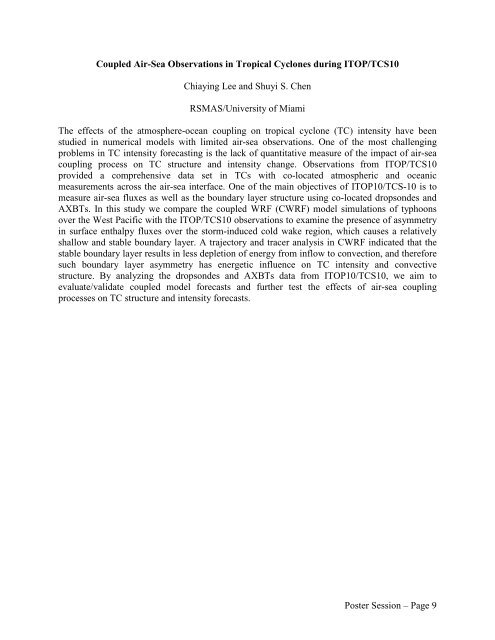65th IHC Booklet/Program (pdf - 4.9MB) - Office of the Federal ...
65th IHC Booklet/Program (pdf - 4.9MB) - Office of the Federal ...
65th IHC Booklet/Program (pdf - 4.9MB) - Office of the Federal ...
You also want an ePaper? Increase the reach of your titles
YUMPU automatically turns print PDFs into web optimized ePapers that Google loves.
Coupled Air-Sea Observations in Tropical Cyclones during ITOP/TCS10<br />
Chiaying Lee and Shuyi S. Chen<br />
RSMAS/University <strong>of</strong> Miami<br />
The effects <strong>of</strong> <strong>the</strong> atmosphere-ocean coupling on tropical cyclone (TC) intensity have been<br />
studied in numerical models with limited air-sea observations. One <strong>of</strong> <strong>the</strong> most challenging<br />
problems in TC intensity forecasting is <strong>the</strong> lack <strong>of</strong> quantitative measure <strong>of</strong> <strong>the</strong> impact <strong>of</strong> air-sea<br />
coupling process on TC structure and intensity change. Observations from ITOP/TCS10<br />
provided a comprehensive data set in TCs with co-located atmospheric and oceanic<br />
measurements across <strong>the</strong> air-sea interface. One <strong>of</strong> <strong>the</strong> main objectives <strong>of</strong> ITOP10/TCS-10 is to<br />
measure air-sea fluxes as well as <strong>the</strong> boundary layer structure using co-located dropsondes and<br />
AXBTs. In this study we compare <strong>the</strong> coupled WRF (CWRF) model simulations <strong>of</strong> typhoons<br />
over <strong>the</strong> West Pacific with <strong>the</strong> ITOP/TCS10 observations to examine <strong>the</strong> presence <strong>of</strong> asymmetry<br />
in surface enthalpy fluxes over <strong>the</strong> storm-induced cold wake region, which causes a relatively<br />
shallow and stable boundary layer. A trajectory and tracer analysis in CWRF indicated that <strong>the</strong><br />
stable boundary layer results in less depletion <strong>of</strong> energy from inflow to convection, and <strong>the</strong>refore<br />
such boundary layer asymmetry has energetic influence on TC intensity and convective<br />
structure. By analyzing <strong>the</strong> dropsondes and AXBTs data from ITOP10/TCS10, we aim to<br />
evaluate/validate coupled model forecasts and fur<strong>the</strong>r test <strong>the</strong> effects <strong>of</strong> air-sea coupling<br />
processes on TC structure and intensity forecasts.<br />
Poster Session – Page 9
















